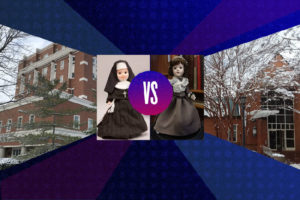Founded as St. Mary’s Female Seminary, St. Mary’s College of Maryland shares its name with many other “Mary” schools across the country. Though SMCM was founded as a non-sectarian boarding school to memorialize religious tolerance in colonial times, its name was very close to the Catholic school formerly known as St. Mary’s School for Boys, aka the University of Dayton. We want this post to go viral, so we have no time for supporting each other as institutions of higher learning with stories and aspirations in common. Instead, it’s Mary vs. Mary, boys vs. girls, seminary vs. school, it’s…
St. Mary’s Smackdown 2018

Competitor 1: St. Mary’s College of Maryland (formerly St. Mary’s Female Seminary)
Fighting out of the navy blue (and white) corner is the national public honors college of Maryland. Coming in strong with 1,533 students, SMCM offers Bachelor’s degrees in the liberal arts and a Master of Arts in Teaching, ready to school its rivals.
Competitor 2: University of Dayton (formerly St. Mary’s School for Boys)
Currently in the red (and blue) corner, a private Catholic Marianist university in Ohio. With 10,899 students, Bachelor’s, Master’s, Doctorate programs, and a law school, will UD crush the opposition beyond a reasonable doubt?
Round 1: 1840 vs. 1850
SMCM: founded in 1840, SMCM is the older (and wiser?) competitor.
UD: clocking in at 1850, UD is the younger (and reckless?) contender.
Results: As they say, age before beauty. Another cool fact about 1840: it was the year Claude Monet was born.
On the other hand, 1850 was the year the London Zoo brought in its first hippopotamus (following a complex chain of events, ultimately leading to the birth of adorable Fiona the hippo at the Cincinnati Zoo!). Hmmmm…Monet vs. hippos. I can guess who would win in a fight, but I’ve never seen a hippo paint a pond filled with water lilies.
Round 2: Doll vs. Dolls
SMCM: The Library, Archives, and Media Center is home to Margaret Brent–that is, the doll version. Brent was credited with keeping the young but full of drama St. Mary’s City alive (it was in its tween years) with her savvy as executor of the governor’s estate. An unmarried woman who immigrated to colonial Maryland in the late 1630s, she was also the first woman to petition the court for the right to vote, though she was denied (see “History — patriarchy” for more information). Fun fact: Margaret Brent (the person, not the doll) has a building on campus, the college’s De Soura Brent Scholars program, and a local middle school named after her.
UD: Roesch Library houses the (in)famous Pauline A. Money nun doll collection. Representing habits of religious orders around the world, the nun dolls also serve as a reminder that the 6th floor silent policy will be enforced…by library staff who may politely suggest a different floor for your group work. They are strongly suspected to move on their own late at night.
Results: Strength in numbers falls in the nun dolls’ favor; however, their commitment to non-violence may hold them back (in mortal if not spiritual matters). Either way, I wouldn’t want to meet any of these dolls down a dark alley.
Round 3: Fire vs. Explosion
SMCM: in 1924, a fire destroyed the Main Building on campus and most of the college’s records. The fire started after an overfilled boiler exploded; as far as we know, this is the school’s only connection to the events in The Shining. The students of SMCM lived in temporary housing until 1925, when a new building–now known as Calvert Hall–was finished.
UD: throughout the 1920s, UD experienced attacks from members of the KKK who targeted Catholics in the Dayton area, many of them immigrants. One of the most serious incidents occurred in 1923, when members of the Klan set off bombs on campus and set a large cross alight. Students and neighbors banded together to drive off the attackers.*
Results: The loss of historically important records, damage to property, and fear yield no real winners here. The 1920s were challenging years on both campuses, yet the communities endured, demonstrating their resilience through hardship.
*SMCM also experienced a great deal of anti-Catholic sentiments as the Know Nothing party gained popularity in the 1850s. During this period, a principal and teacher were fired for selling an anti-Catholic book, The School-girl in France, or, The Snares of Popery.
Round 4: Mascots — Man vs. Nature
SMCM mascot: Solomon the Seahawk, osprey. Locally, Solomons is a tourist spot in Maryland named for Isaac Solomon, cannery owner/operator and inventor of a speedy method for canning food.
UD mascot: Rudy Flyer, human. Adopted as the school’s mascot in honor of the Wright B. Flyer, invented in the First in Flight city of Dayton (don’t @ me, North Carolina).
Results: Based on punning alone, I don’t know of any mascot that beats rUDy Flyer. However, I have to wonder whether Rudy’s ever-present aviator goggles hide a sinister secret.
Both mascots are creatures frequently found in the sky, and I like to believe they would coexist peacefully. Solomon could share his fish catches with Rudy, and Rudy could provide a perch on the Wright B. Flyer when Solomon’s wings get tired.
As you may have suspected by now, we think both SMCM and UD are great, whether they are “St. Mary’s” schools today or in the past. Let us be united in the ways our histories parallel and enjoy that somehow the libraries at both schools have doll collections.
Of course, we’re more than willing to hear dissenting opinions on this topic. Who do you think wins St. Mary’s Smackdown 2018?
Our friendly rivals at the University of Dayton Libraries have posted this piece on their blog here.
Find more information about the history of St. Mary’s College of Maryland in the following resources:
-
- About St. Mary’s: History of the College. http://www.smcm.edu/about/history4/history-of-the-college
- Archives of St. Mary’s College of Maryland
- Haugaard, J.B., Wilkinson, S.G., and King, J.A. St. Mary’s: A “When-Did?” Timeline (2007). https://library.smcm.edu/wp-content/uploads/2014/07/editedWhenDid-Timeline1.pdf
Find more information about the history of the University of Dayton in the following resources:
-
- About the University of Dayton: History. https://udayton.edu/about/history.php
- Trollinger, W.V. “Hearing the Silence: The University of Dayton, the Ku Klux Klan, and Catholic Universities and Colleges in the 1920s” (2013). History Faculty Publications. Paper 11. http://ecommons.udayton.edu/hst_fac_pub/11





